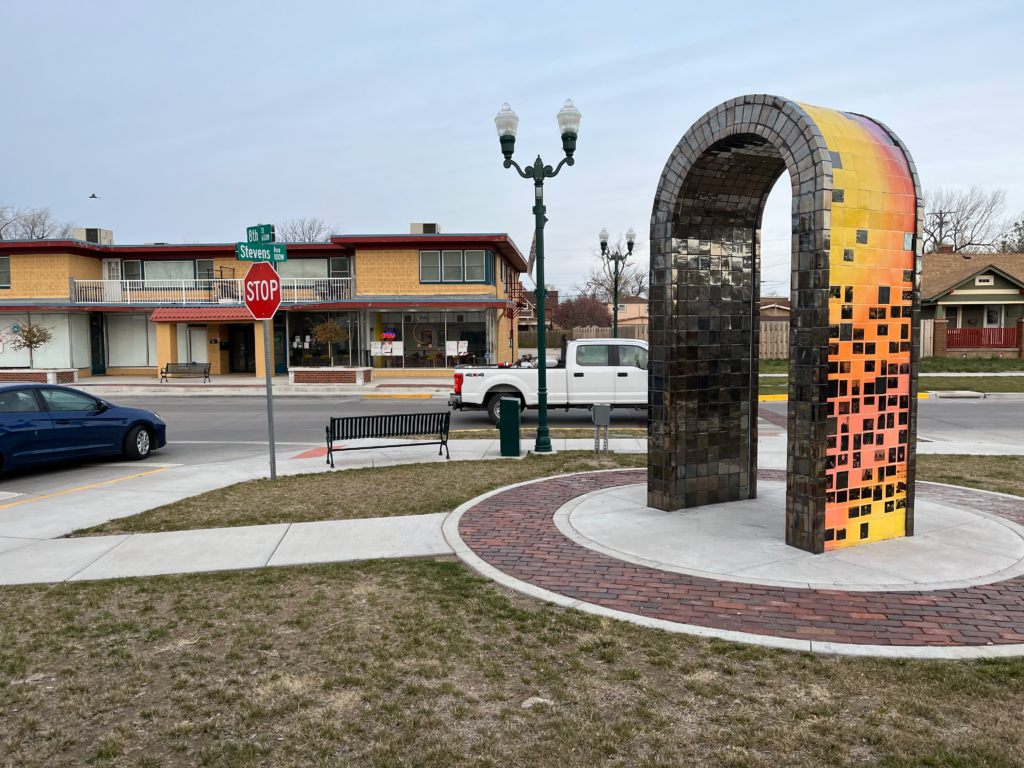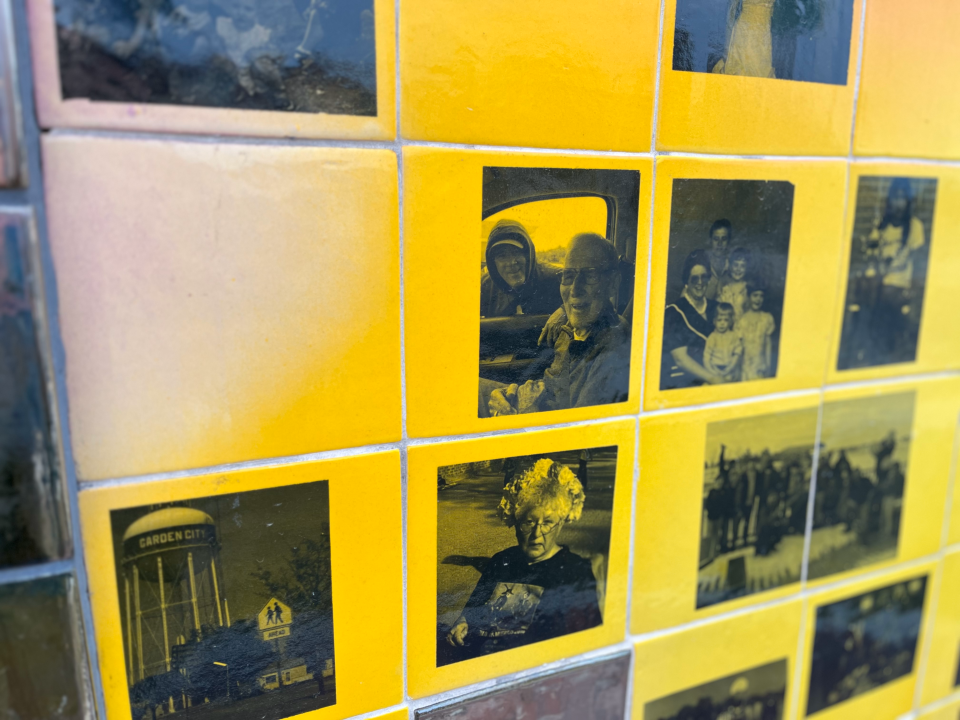Photo album-inspired arch in Garden City reflects an artist’s gratitude and community’s history

"El Arco," a sculpture by Armando Minjárez Monárrez, was erected in Garden City last year. (Brett Crandall for Kansas Reflector)
In Garden City — the rural heart of the high plains — stands “El Arco,” a 14-foot-tall sculpture erected in 2023.
You can find the artwork on 8th Street, in Garden City’s historic downtown, across from Central Cup Coffee House. Clad in a yellow-orange ombre of ceramic tiles printed with a “photo album” of the city that helped mold the artist — Armando Minjárez Monárrez — the sculpture both reflects the life of the artist and our own lives and times. It suggests both the opportunities and restrictions of 2020s rural America, and most of all a very American tale of cobbling together our futures with the support and guidance of our communities.
Since his days studying art at Garden City Community College in 2005, western Kansas has held a soft spot in Minjárez’s heart. In early 2021, he heard from longtime mentor Carole Geier about a Garden City Arts grant cycle with a nearing deadline. Ideas of what forges community quickly generated a proposal submission.
He has known Geier since he lived in Garden City, he said.
“She is someone who has made an effort to stay in touch with me — I wouldn’t have been able to participate in (this grant) it wasn’t for her,” he said. “I’m grateful for her.”
Minjárez’s submission was selected, and the execution of the project started.
This pandemic project took longer than expected. Garden City Art’s director, Caty Guthrie, said they faced “supply chain issues,” with the ceramic arch originally meant to be constructed from steel. These issues coupled with a 3.5 hour drive back to Garden City from Wichita, where Minjárez is now based, resulted in slow progress.
Like a true Midwesterner, Minjárez saw the string of hours-long trips as chances to “reconnect.”
The many facets of Minjárez’s talents are captured in the arch’s details. His early interest in architecture and design found sanctuaries at Garden City Community College’s art and theater departments.
He cites David Kinder — the painting professor who “saw something in me … and offered me a scholarship. … That’s how I even ended up there” — as well as since-retired theater head Skip Mancini and her husband, Vincent.
“They both became mentors of mine,” Minjárez said.
He added: “He’s an architect, and him knowing that I wanted to study architecture … he was someone that I could go to and ask questions about, you know, ‘What school should I go to?’ ‘What things should I be doing?’ And Skip gave me some great opportunities, designing sets for … shows like ‘Sweeney Todd,’ ‘Wiley and the Hairy Man,’ and ‘The Importance of Being Earnest.’ ”
Seemingly separate studies of art can sometimes lead us to “pick a lane” when it comes to honing our crafts. However, Minjárez’s lifelong practice as an artist led him to a cumulative proposal for Garden City Arts.
Needing to honor both the history of Garden City and the ever-expanding diversity of its current population, Minjárez remarked, “I love a good challenge and that was definitely one.”
His cognizance and study of iconography led him to avoid certain approaches.
“Being myself Mexican, I know that not every brown person out there is Mexican,” he said. “There’s other nationalities from Latin America that are living in the city — Africa and Southeast Asia — so I didn’t want to use national symbols, flags or anything like that. That’s a really easy way to alienate people.”
A solution for the supply shortages and the choice of imagery finally came, perhaps thanks to another mentor from his time in Garden City: Brian McCallum, a ceramicist and current department head at Garden City Community College.
A detail of the “El Arco” sculpture shows images from residents’ lives in the Garden City area. (Brett Crandall for Kansas Reflector)
On the outer sides of this towering arch are photographs submitted by Garden City residents, transferred onto yellow-orange ombre ceramic tile, giving it a faded-yet-hallowed Polaroid quality.
“I’ve always wanted to try this technique of using actual photographs and transfer onto ceramic,” Minjárez said. “That’s a way for people to really see themselves in this piece in a very literal way. In kind of a nostalgic way as well, because of the nature of the projects, where I was asking people from the community to submit photos. I knew that I had a list of people that I wanted to reach out to, not knowing whether they still live there or not.”
The project showcases histories from long before Minjárez arrived.
“It also provided an opportunity to go back into historical archives and look at photos from 100 years ago or even older, from when Garden City just started,” he said.
The difference in how photography has been used during Garden City’s history shows throughout the piece.
“I personally love photo albums,” Minjárez said, lighting up. “What do they like to celebrate and capture? You can learn about someone’s family and who they are through some of these, I guess, relics, right? Family relics and memories. I wanted to kind of have the same feeling.”
Step inside, however, and you’re met with your own reflection in the shining, silver tile.
“I wanted it to be something reflective, a material so that if anyone is there looking at the photos on the outside, they can kind of go on the inside of the arch and maybe see a reflection of themselves today,” he said.
This writer was honored to have a local Pride event he produced now cemented in the city’s history — an event a younger version of myself driving around Garden City would have actively avoided for fear of being outed.
How times can change.
When talking to residents about the new installation, many have remarked on the shining material inside, complaining the light flashes at them while driving down 8th Street. I believe this is another example of art imitating life, and a testament to Minjárez’s thoughtful design. People can have a difficult time truly reflecting in today’s scrollable social structures.
When those flashes of the past come to mind, it may be worth your while to pull over a minute, scan over the little details and savor those moments with people that forged us with gratitude. Maybe step in the mirrored center and treasure the earned wisdom and experience. As a native to the area, I couldn’t help but think of my own “pillar people” who saw potential in me, while others saw only unchanneled over-excitement.
“The mentorship that I received while I was there from (Kinder, Geier, McCallum, the Mancinis), opportunities and connections that everyone afforded me at the time — to think about 20-year-old me, dreaming of designing structures for the public to use and to kind of serve some higher purpose. To get to do that now at this level, it’s quite remarkable,” Minjárez said. “I don’t know if that’s too lofty, but it feels like a gift that was given to me, right? (It’s) also a gift that I can leave behind for the people that got to participate.”
You can learn more about his art at ArmandoMinjarez.com, or follow him on Instagram @armando__minjarez
Brett Crandall is an actor, writer, producer, puppeteer and LGBTQIA+ activist based in Garden City. Through its opinion section, the Kansas Reflector works to amplify the voices of people who are affected by public policies or excluded from public debate. Find information, including how to submit your own commentary, here.
The post Photo album-inspired arch in Garden City reflects an artist’s gratitude and community’s history appeared first on Kansas Reflector.


